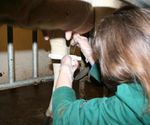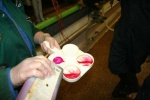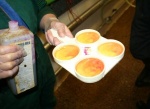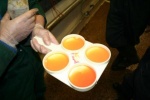California Mastitis Test
Also known as: California Milk Test — CMT
Introduction
The California Mastitis Test (CMT) is a qualitative cow side test for detecting subclinical intramammary infections (IMI) in cows.
The test works by using a detergent which lyses the somatic cells present in the milk and denatures any DNA present. This reaction increases the viscosity of the mixture, the extent of which is correlated to the number of somatic cells present. Some commercially available test solutions have a pH indicator present (bromcresol purple) which means the mixture will change from a red to a purple colour if the pH is high which is often seen when mastitis is present. Although several commercial solutions are available, many farms use normal detergent (“Washing up liquid”).
A suggested protocol to use is:-
- Discard the first two squirts of milk (foremilk)
- Milk approximately 1-2 squirts into each well of the paddle corresponding to each quarter
- Tilt the paddle so equal amounts of milk are in each well
- Add equal volumes of the test solution
- Shake the paddle to ensure mixing of the milk and test solution
- Interpret viscosity and colour changes
- California Mastitis Test
The advantages of this test are that it is cheap, simple and rapid. It also gives an indication of individual quarter infection status which may be missed by four quarter composite sampling. The disadvantage is the poor sensitivity of the test and the relatively subjective interpretation. Using the scoring system, if a trace or higher is considered positive, approximately 90% sensitivity can be attained (Biggs, 2010).
CMT has many on farm applications for management of subclinical mastitis. On farms that don’t do individual somatic cell count (SCC) recording, a CMT can be used to screen the herd after a high bulk tank SCC result. Cows identified as positive can then be treated. The CMT can also be used to monitor known problem cows, assess the efficacy of treatment of subclinical infections, and identify cows for treatment at drying off if selective dry cow therapy is used.
| Category | Score | Description of reaction |
| Negative | 0 | Mixture of milk and test fluid stays unchanged and can easily be shaken |
| Weak positive/trace | 1 | Mixture is slightly mucous but can still be shaken |
| Positive | 2 | With movement of the mixture an unmistakable mucous formation can be seen. It is still possible to tip a small portion of the mixture out. |
| Strong positive | 3 | Jelly-like, mucous consistency is formed and is difficult to shake the mixture. It is no longer possible to tip out and surplus liquid. |
- Table 1. Scoring system for interpretation of CMT results (Adapted from Leach et al, 2008)
References and further reading
Biggs, A., 2009. Mastitis in Cattle, 1st Edition. The Crowood Press Ltd.
Blowey, R., Edmondson, P., 2010. Mastitis Control in Dairy Herds, 2nd Edition. CABI International.
Leach, K.A., Green, M.J., Breen, J.E., Huxley, J.N., Macaulay, R., Newton, H.T., Bradley, A.J., (2008). Use of domestic detergents in the California mastitis test for high somatic cell counts in milk. Veterinary Record 163:566-570
| This article was written by Nick Lyons MA VetMB CertCHP MRCVS on April 26, 2011. |
Error in widget FBRecommend: unable to write file /var/www/wikivet.net/extensions/Widgets/compiled_templates/wrt693c113d748b57_33513000 Error in widget google+: unable to write file /var/www/wikivet.net/extensions/Widgets/compiled_templates/wrt693c113d7bf355_89850621 Error in widget TwitterTweet: unable to write file /var/www/wikivet.net/extensions/Widgets/compiled_templates/wrt693c113d821cf1_09726805
|
| WikiVet® Introduction - Help WikiVet - Report a Problem |



